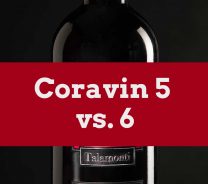Does Pinot Grigio Go Bad? The Surprising Truth About This Wine
Last Updated on August 1st, 2023
Reader Disclosure Disclosure: We may earn commissions for purchases made through links on our site. Learn more on our about us page.Imagine this: You’ve had a long day at work, and you would like nothing more than to go home and pour yourself a glass of your favorite wine, Pinot Grigio.
The only issue is when you go to take a sip, something tastes- different. You start to wonder if maybe it’s gone bad, but you never thought it could go bad.
So now you’re left wondering if you’ve been handling your wine the wrong way and are left with the curious question: Does Pinot Grigio go bad?

Does Pinot Grigio Go Bad After Opening?
To fully answer this question, we need to first look at wine as a whole and see how Pinot Grigio compares. Technically, every wine goes bad after it is opened, just like with any other consumable product.
However, the moment you uncork a bottle of wine and that wine is exposed to oxygen. Its lifespan is drastically cut short.
Air is a wine’s worst enemy because of oxidation and if you’re looking for the cliff notes version of the oxidation of wine, here it is:
Your Pinot Grigio will not only taste like vinegar, but it will be vinegar if it’s exposed to air long enough.
Depending on the type, wine can go bad either really fast (within a day or two) or last long enough for you to enjoy a whole bottle until the end of the week.
If a wine is more tannic and dry, it will generally last longer than sweeter ones. Commercially produced wines also tend to last longer than natural wines. Red wines typically last longer than white wines.
Pinot Grigio is a dry, acidic white wine. This variety of white wine has been said to be enjoyed sooner rather than later because it is harvested earlier, and its fermentation process is shorter.
Even though Pinot Grigio is considered a dry wine, it is also lower in tannins; therefore, it has a smaller window of staying fresh.
Pinot Grigio is very aromatic and can lose this property quickly after opening it. It is suggested that this white wine is enjoyed best when it is consumed one to three days after uncorking it.
If you are uncorking it and not storing it correctly, this can continue to decrease the amount of time you can enjoy it. After you’ve opened your wine, make sure you are recorking it and sticking it in the fridge.
It might even be a good idea to buy a wine stopper if you happen to get a bottle and can’t put the cork back on.
Does Pinot Grigio Go Bad in the Fridge?
If you’ve made it this far, you might have already been able to guess the answer to this question. Still, yes, unfortunately, your Pinot Grigio can and will eventually go bad in the fridge after a certain amount of time.
The question is not if but how fast it can go bad in the refrigerator. Pinot Grigio is often considered to be a medium-bodied wine. Body refers to how heavy or full it feels in your mouth and is mainly measured by how much alcohol is in it.
Full-bodied white wines like Chardonnay oxidize faster, causing them to go bad quicker even if they are correctly stored.
There is some mixed information out there about this, but generally, Pinot Grigio should be able to last anywhere from 5-7 days in the fridge with its top on.
Keep in mind that while it can last this long in the refrigerator, the longer it is, its aromatic properties will dissipate as well.
What if I Left My Pinot Grigio in the Car on a Hot Day (After I Opened It)?
Typically, Pinot Grigio is at its best when stored at a cool temperature between 45-50 degrees Fahrenheit. Remember that the quality of the wine automatically starts to decrease after it has been opened; this will only worsen if it’s left in the car on a hot day.
When you leave an already open bottle of wine in a hot car, it ages the wine faster than if stored in a colder place; depending on how long it is left in the car and how hot it is outside, it may be able to be salvaged.
First, however, make sure that you inspect your wine bottle to see if there are any signs that the wine has been damaged.
Here are a few questions to ask yourself when you inspect your wine:
- Has it been in the car long?
- Is the cork sticking out of the bottle more than it should?
- Is the wine darker in color than when you last saw it?
- Is the wine leaking?
If the answer is yes to any of these, it may be wise to count your losses and toss your Pinot Grigio out.
What if I Left My Pinot Grigio in the Car on a Cold Day and It Froze (After I Opened It)?
Good news: you can definitely drink wine that has been frozen, even if it means that the way it was frozen is not the usual. However, make sure that you are inspecting your bottle. Just as wine expands when it heats up, it also expands when it freezes.
You should be good as long as you don’t see any broken glass as you’re inspecting. It is essential to know that the flavor may differ because it was frozen, but it shouldn’t be that drastic.
If you don’t like the altered taste but don’t want to waste it, use it for cooking. Pinot Grigio is a great wine to cook with.
There are a variety of seafood and pasta dishes you can create using it. If you still want to drink the thawed wine, you could also make some wine cooler recipes. Hey, a lot of people drink iced coffee in the cold weather; why can’t you drink a wine cooler?
Now that you know your Pinot Grigio can go bad, hopefully, you’re not leaving it in your car. But if you have, that’s okay; there are still ways to utilize your pinot.
Whether that’s by making a dish, or making wine coolers, just remember that if you want to drink it: make sure the cork is on, store it in the fridge, and enjoy.
Final Thoughts on Telling if Pinot Grigio has Gone Bad
Oxygen is wine’s enemy number one. The moment you open the bottle, the span for consumption gets shorter, so you need to be careful while storing it.
Leaving a bottle of wine in extreme heat or cold conditions is likely to ruin the wine entirely, and you should not consume it.
Pay attention to the smell and change of coloring to see whether the wine is still safe to drink. If you are not sure about it, it’s better to be safe than sorry – so we advise you to throw it away.


















